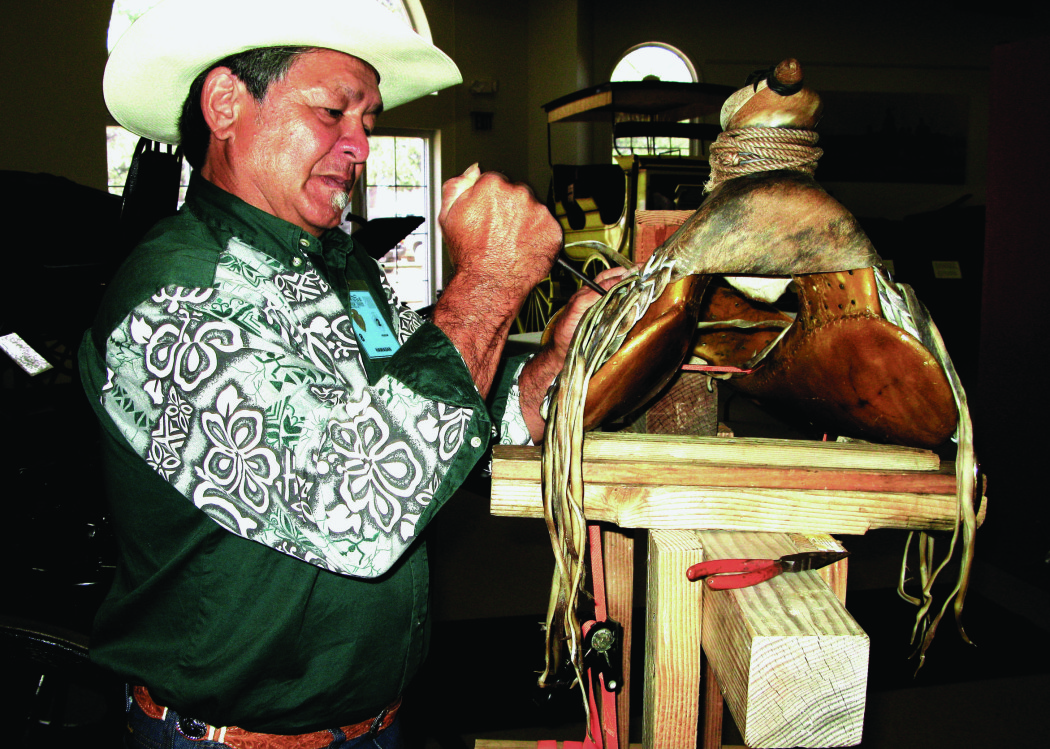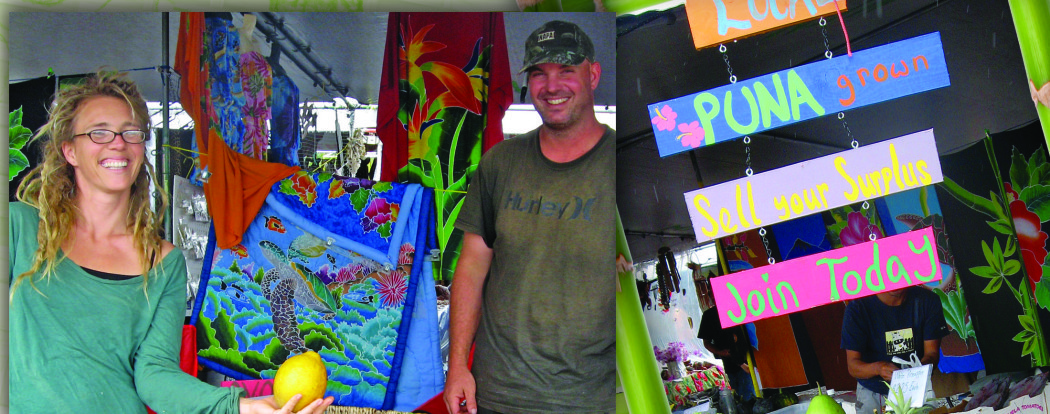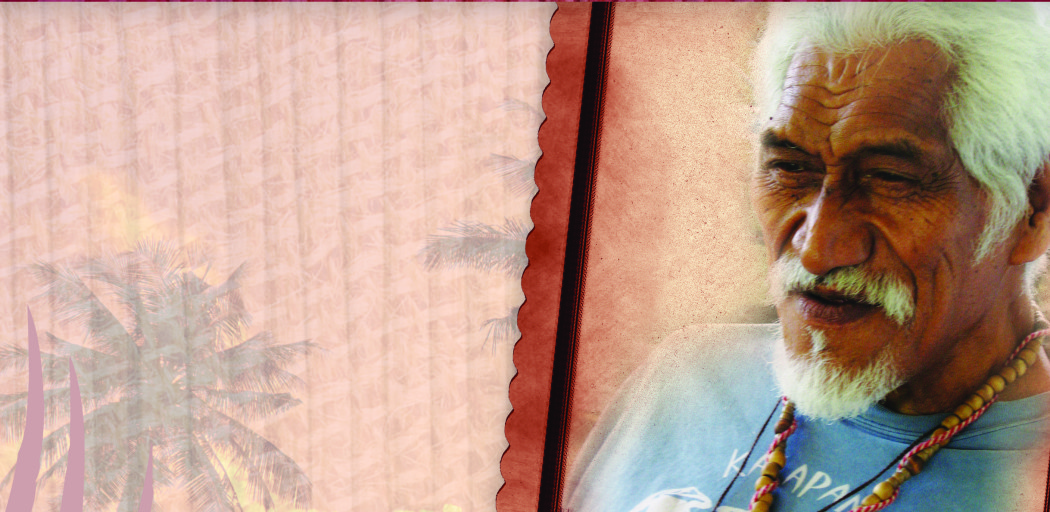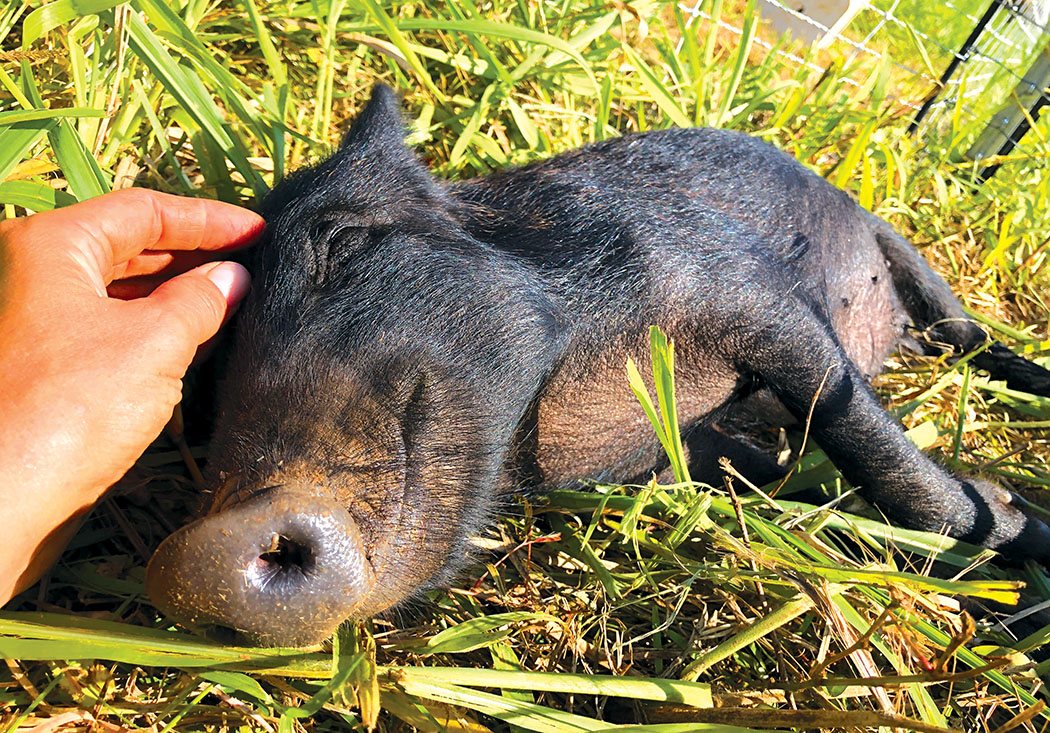
The Art of Noho Lio O Paniolo: Making the Hawaiian Tree Saddle
 By Denise Laitinen
By Denise Laitinen
Few pieces of equipment are as important to a paniolo (Hawaiian cowboy) as his/her saddle. Just as a golfer needs good clubs and a mechanic needs good tools, so does a cowboy need a good saddle.
“My dad worked for Parker Ranch and the saddle was their main tool,” explains Alvin Kawamoto, a respected saddle maker from Kohala. “They rode their horses from one place to the other, so it had to work.”
The paniolo on Hawai‘i Island date back to 1833 when three vaqueros—Spanish/Mexican cowboys—arrived at Kawaihae Harbor to teach Hawaiians how to rope and herd cattle and ride mounted horses. Over the years the paniolo developed their own style of saddle making—known as the Hawaiian tree saddle—so named because cowboys went into the forest and cut the tree, which they carved into a saddle.
“The Mexican model [saddle] was heavier and bulkier,” says Dr. Billy Bergin, past president of the Paniolo Preservation Society and author of Loyal to the Land: The Legendary Parker Ranch 750-1950, volumes 1 and 2. “The natural instinct of the Hawaiians was to use lighter materials. They refined the saddle seat to make it concave, so it molded to your [butt].
“The prototype of the Hawaiian tree saddle originated in the early 1900s,” explains Bergin. “It’s changed very little in the past century. The native Hawaiians came up with a model that was hard to improve upon.”
Today, Alvin Kawamoto, a fourth-generation cowboy, is one of the few Hawaiian tree-saddle makers left.
Kawamoto started working at Parker Ranch during summer breaks from school when he was 14. “We were brought up on the ranch. We did our own repairs on the saddles. I learned from my dad, who learned from my grandfather (who also worked for Parker Ranch), who learned from his dad, my great grandfather.”
Kawamoto recalls how his dad tried to steer him away from a career as a cowboy. “My dad worked from when he was 14 until he retired. We grew up in the age when my dad wanted us to have an education because he never had [one].”
Not only did Kawamoto get an education, he went on to become an educator – spending 31 years as an elementary school teacher in Kohala.
But Kawamoto didn’t abandon his cowboy roots. In the 1970s, he started a side business making Hawaiian tree saddles. “I got started when I was in my 20s, dressing up the saddles, putting together the patterns, and putting the saddle together,” explains Kawamoto. He went into business for himself because of the demand, primarily from other paniolo. “People kept asking me to make saddles and it spread by word of mouth.”
He retired as a school teacher several years ago but is still going strong making saddles.
From Tree to Saddle
Overall, it takes about a month to make a Hawaiian tree saddle. The basis of the saddle is comprised of four parts: the fork (front), two bars (for the left and right sides), and the seat. Kawamoto starts the saddle-making process with a trip in the woods to look for a Neneleau tree. Found in forested areas of Kohala, Paauilo, and Kona, the neneleau tree is the preferred tree of choice because of its tight grain.
“Typically, you go to look at a tree for one saddle,” says Kawamoto. “You’re not there to make multiple saddles.”
Kawamoto follows the Hawaiian principle of only taking what you need. “You’re looking for fallen trees. You really wouldn’t cut the nice trees. No sense cutting a nice big tree for a few parts. You look for a fallen tree and take what you need.”
He points out that you don’t necessarily need a big tree either. He looks for a tree with branches that fork. Then he uses the branch to make the bars, or sides of the saddle. The only large part of the tree needed is for the seat, which is usually about 13 inches in diameter.
The wood has to dry before being carved into a saddle. “If you’re in a rush and do it while the wood is still green the saddle will be heavy. If you wait until the wood dries out then the saddle is light,” explains Kawamoto.
After the wood dries, the process of turning logs and branches into a saddle begins. The fork, seat, and bars are hand-hewn with a hatchet, then filed down with a rasp, a process that takes several days. The four parts of the saddle are put together with wooden dowels instead of nails.
After the assembled wood is made nice and smooth it’s covered with rawhide. “All my rawhide is from my own cattle,” says Kawamoto, who has 50 head of cattle on his 140-acre ranch. He dries and salts his own hides, a process that takes two-to-three weeks.
Some of the saddle processes occur at the same time. For instance, Kawamoto might be salting the hide at the same time he is waiting for the wood to dry.
Applying the rawhide is a team effort. “You always need a helper when applying the rawhide,” says Kawamoto. It takes three guys nearly four hours: one person holds the saddle steady while another applies the rawhide and a third person sews the rawhide pieces together.
The saddle is then left to dry for about a week. “You have to store it away from the sun, otherwise it’ll dry unevenly,” explains Kawamoto.
The saddle is far from finished, though. While the rawhide saddle dries, Kawamoto starts creating the leatherwork, or as he calls it—dressing up the saddle. The trimming, cutting, and stamping of the leather, in addition to braiding the rawhide, can take up to two weeks.
Each saddle maker has his own unique designs and patterns used in leatherwork. Kawamoto’s stamps use a pattern his grandfather gave him. He can look at a saddle and tell if it’s his creation just from the stamping. Using metal tools, each stamp is imprinted into the leather by hand. He alternates a variety of stamps to create patterns around the perimeter of the saddle.
Rawhide is used extensively on Hawaiian tree saddles. “Mainland cowboy saddles use an awful lot of leatherwork,” says paniolo historian Bergin. After the tanning process, leather may be a more flexible form of animal hide, but Hawaiian tree saddles use a minimal amount of leatherwork and more rawhide than their mainland counterparts. Explains Bergin: “Rawhide is less expensive and fares well when it gets wet.”
Alvin hand braids the adjustor, made of rawhide, which goes around the saddle to make sure the saddle stays tight. Early Hawaiian cowboys realized that the back of every horse is different. The rawhide adjustor allows them to precisely adjust the saddle to the back of each horse.
The most distinctive feature of the Hawaiian tree saddle—and the one that identifies a Hawai‘i Island-made saddle is the aweawe. Aweawe, Hawaiian for tentacles, refers to the rawhide rigging used to keep the saddle on the horse.
“The aweawe is unique to the Big Isle,” says Kawamoto. “Only people on the Big Island use aweawe. Maui has wilimokou, similar but with smaller laces than the aweawe, and Kauai doesn’t have rawhide rigging on their saddles.”
It takes about three hours to wrap the aweawe and cut the laces, then another three to four hours to braid it. “I don’t do it all at once,” explains Kawamoto.” I cut it and let it dry to where I want it and then I braid it, usually the next day.”
When all the stamping, rigging, and braiding are finished, the stirrups are added and the saddle is completed. Some saddles have open-toe stirrups, while others have closed-toe, leather stirrups called tapaderos.
Kawamoto doesn’t recall how many saddles he’s made over the decades but he can tell you right away how many pairs of tapaderos he’s made.
“I’ve made 80 pairs of tapadaros,” he says with a chuckle. “I remember because they’re hard to do. I just sold my 80th pair and I know I made a lot of saddles without tapadaros.”
“It takes me four hours just to sew the outer sides [of a tapadero] together and then another four hours to sew the top leather flap on. It’s a lot of maneuvering and moving. If you drill in the wrong place—oh man, it’s a lot of work to fix. So it takes one day just to make one tapadero. Then I have to make a second one for the other leg. ”
A true artisan, Kawamoto doesn’t mass-produce saddles. He custom makes one saddle at a time by order. “Since I started I’ve wanted to make a saddle that I could put somewhere to sell and so far I haven’t been able to do that. Before I can get it to a store, it’s sold. Whenever I think I’m caught up with saddle orders I get a call and start all over again.”
With only a handful of Hawaiian tree saddle makers remaining, Kawamoto is well aware that his is a dying art. It’s all the more reason to keep doing what he’s doing.
“As long as the demand is there I’ll keep doing it.” ❖
Contact writer Denise Laitinen at wahineokekai@yahoo.com.


